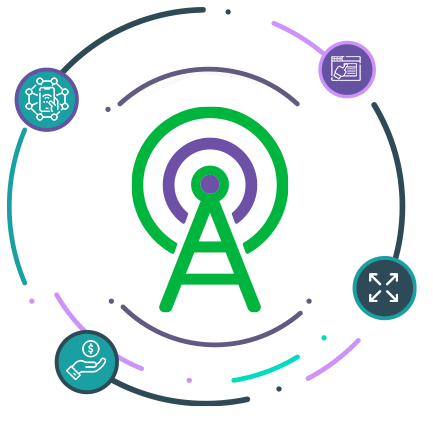In today’s telecom networks, it’s essential to keep up with both legacy protocols and new digital technologies. One of the key tools that helps telecom operators bridge this gap is the Sigtran gateway. For engineers working in telecom, understanding this gateway is important for integrating modern applications with traditional signaling networks like SS7.
Let’s break down what a Sigtran gateway is, why it matters, and how it’s changing telecom infrastructure.
What Is SIGTRAN and Why Do We Need a Gateway?
SS7 (Signaling System Number 7) has been used in telecom for over three decades to control voice calls, SMS, and various value-added services. It’s the protocol used to manage signaling—the exchange of information between network elements—across different parts of the telecom infrastructure.
But SS7 was originally designed for traditional circuit-switched networks, not for today’s fast, low-cost IP-based systems. That’s where SIGTRAN comes in. SIGTRAN (SS7 over IP) allows telcos to send SS7 signals over IP networks instead of using expensive and less flexible dedicated circuits.
However, to actually make this work in a live telecom environment, a middle layer is needed to translate, manage, and route this signaling traffic. That middle layer is the Sigtran gateway.
The Role of a Sigtran Gateway in Modern Telecom Networks
A Sigtran gateway serves as a bridge between SS7 networks and IP-based applications. It enables communication between traditional core telecom systems (like HLR, MSC, and VAS platforms) and modern digital services.
Here’s what the Sigtran gateway does:
- Converts traditional SS7 messages into IP packets using SIGTRAN protocols like SCTP.
- Routes signaling traffic to and from mobile and fixed-line infrastructure.
- Supports modern APIs, so internal systems and third-party applications can easily access subscriber data or trigger services like SMS, USSD, and LBS.
- Reduces costs by eliminating the need for expensive SS7 cards and hardware.
- Enables faster deployment of new telecom services.
Inside the Sigtran Gateway: How It Works
According to hSenid Mobile’s SIGTRAN solution, the gateway stack includes the following key components:
- IP Layer – The foundation for carrying data over internet-based networks.
- SCTP (Stream Control Transmission Protocol) – Ensures reliable transport of messages across IP.
- MTP (Message Transfer Part) – Handles signaling message delivery.
- SCCP (Signaling Connection Control Part) – Supports global title translation and routing.
- TCAP (Transaction Capabilities Application Part) – Manages database interactions like number portability.
- MAP (Mobile Application Part) – Handles mobile-related services such as authentication and SMS routing.
The gateway has two types of APIs:
- Direct API calls – These are made by internal applications to the gateway using HTTP.
- Flow API calls – These are made from the gateway to core telecom systems, like HLR or MSC.
This two-layer API structure makes the Sigtran gateway very flexible, enabling integration with both legacy and modern systems.
Benefits of Using a Software-Based Sigtran Gateway
Traditionally, many telcos relied on proprietary hardware-based SIGTRAN stacks. These were costly, rigid, and hard to scale. Today, software-based gateways like the one built by hSenid Mobile offer clear advantages:
- Cost-Effective – No need to buy expensive SS7 cards or third-party stacks.
- Customizable – Telcos can tailor the gateway based on specific network needs.
- API-Ready – Ready-made APIs help developers build new services quickly.
- Lightweight – Uses fewer resources and works efficiently with core network functions.
- Proven in the field – These solutions are already powering services like SMS Centers, USSD Gateways, LBS platforms, and authentication systems.
Real-World Use Cases of Sigtran Gateway
Here are just a few examples of how telcos can use a Sigtran gateway:
- Mobile Data Authentication – Authenticate subscribers when they offload data onto Wi-Fi hotspots.
- Multi-SIM Management – Retrieve IMSI and MSISDN data for multi-SIM users.
- Location-Based Services – Get routing info from MSC for LBS applications.
- MNP Call Routing – Manage call control for ported numbers in fixed-line services.
- HLR Integration – Query subscriber info like teleservices, routing categories, and device status.
Future-Proofing with Sigtran Gateway
As 5G and next-gen services become more common, telcos need tools that are flexible and scalable. A Sigtran gateway provides a modern, IP-based approach to legacy signaling. This helps ensure compatibility with future platforms while still supporting vital 2G/3G services in many regions.
Because of its software nature, the gateway can be continuously updated, patched, and improved. New APIs can be exposed as the business needs grow. It’s a long-term investment for telcos planning for hybrid environments.
Final Thoughts
The Sigtran gateway is an essential part of modern telecom architecture. It helps telcos transition from legacy SS7 networks to flexible, cost-effective IP-based solutions without losing access to core services. For telecom engineers, understanding how this gateway works—and how it supports new service layers—is key to staying competitive in a rapidly evolving market.
By using a customizable, software-based solution like hSenid’s SIGTRAN Gateway, telecom operators can innovate faster, reduce costs, and future-proof their infrastructure.








